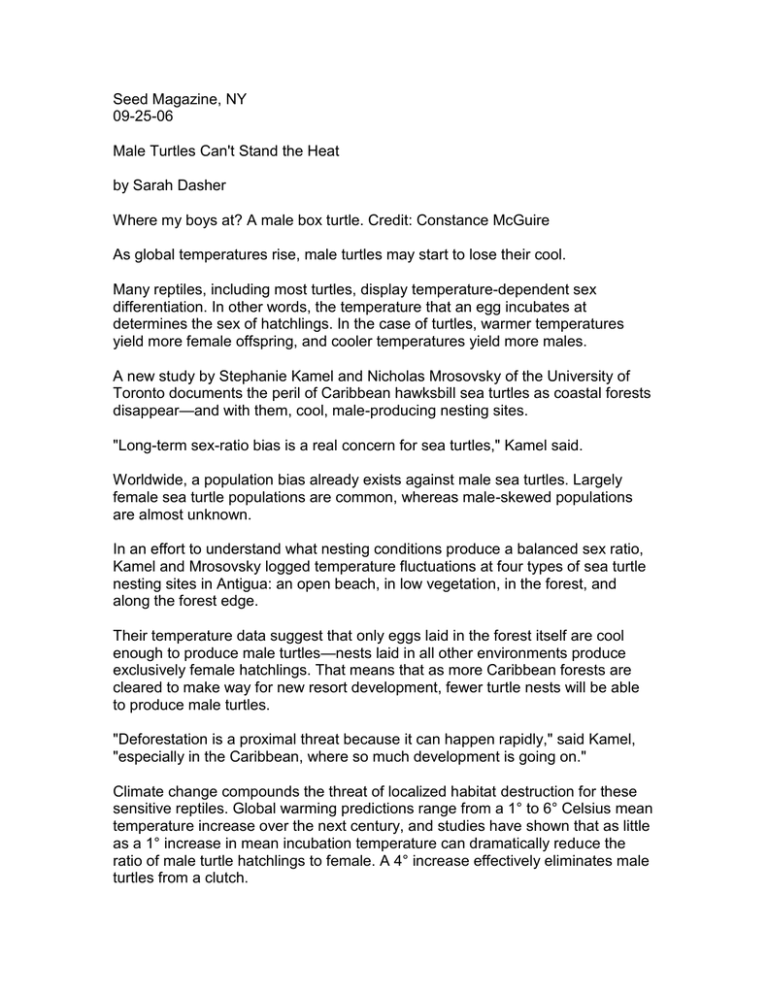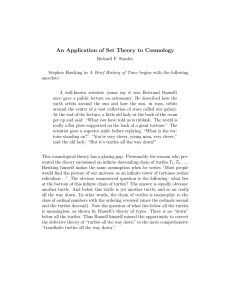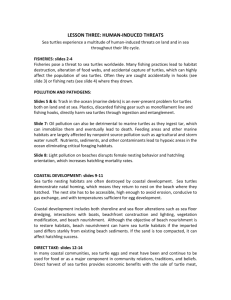
Seed Magazine, NY
09-25-06
Male Turtles Can't Stand the Heat
by Sarah Dasher
Where my boys at? A male box turtle. Credit: Constance McGuire
As global temperatures rise, male turtles may start to lose their cool.
Many reptiles, including most turtles, display temperature-dependent sex
differentiation. In other words, the temperature that an egg incubates at
determines the sex of hatchlings. In the case of turtles, warmer temperatures
yield more female offspring, and cooler temperatures yield more males.
A new study by Stephanie Kamel and Nicholas Mrosovsky of the University of
Toronto documents the peril of Caribbean hawksbill sea turtles as coastal forests
disappear—and with them, cool, male-producing nesting sites.
"Long-term sex-ratio bias is a real concern for sea turtles," Kamel said.
Worldwide, a population bias already exists against male sea turtles. Largely
female sea turtle populations are common, whereas male-skewed populations
are almost unknown.
In an effort to understand what nesting conditions produce a balanced sex ratio,
Kamel and Mrosovsky logged temperature fluctuations at four types of sea turtle
nesting sites in Antigua: an open beach, in low vegetation, in the forest, and
along the forest edge.
Their temperature data suggest that only eggs laid in the forest itself are cool
enough to produce male turtles—nests laid in all other environments produce
exclusively female hatchlings. That means that as more Caribbean forests are
cleared to make way for new resort development, fewer turtle nests will be able
to produce male turtles.
"Deforestation is a proximal threat because it can happen rapidly," said Kamel,
"especially in the Caribbean, where so much development is going on."
Climate change compounds the threat of localized habitat destruction for these
sensitive reptiles. Global warming predictions range from a 1° to 6° Celsius mean
temperature increase over the next century, and studies have shown that as little
as a 1° increase in mean incubation temperature can dramatically reduce the
ratio of male turtle hatchlings to female. A 4° increase effectively eliminates male
turtles from a clutch.
Some turtles have responded to recent warming trends by nesting earlier in the
season. Over the past ten years, studies by John Tucker of the University of
Illinois and Frederick Janzen of Iowa State University have documented
individual turtles nesting between 10 and 21 days earlier.
But behavioral change is limited to individual turtles, and there is no evidence
that whole species, or even whole populations, will adapt in this way. According
to Janzen, air temperature is only one of many indicators that signal the start of
nesting season. Other factors less influenced by global warming, such as ground
temperature and day length, ultimately influence how early turtles will start to
nest.
"These turtles have a limited amount of behavioral plasticity," Janzen said, "And
then they have to evolve."
Send this article to: Del.icio.us Spurl Ma.gnolia Digg Reddit Newsvine A Friend
Male Turtles Can't Stand the Heat, written by Sarah Dasher, posted on
September 25, 2006 01:20 AM, is in the category Environment & Ecology.










